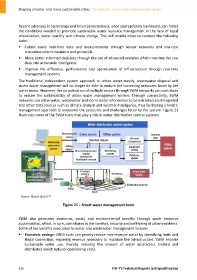Page 542 - Shaping smarter and more sustainable cities - Striving for sustainable development goals
P. 542
Recent advances in technology and interconnectedness, once appropriately harnessed, can foster
the conditions needed to promote sustainable water resource management in the face of rapid
urbanization, water scarcity and climate change. This will enable cities to conduct the following
tasks:
Collect easily real‐time data and measurements through sensor networks and low‐cost
innovative communications and protocols.
Make better informed decisions through the use of advanced analytics which translate the raw
data into actionable intelligence.
Improve the efficiency, performance and optimization of infrastructure through real‐time
management systems.
The traditional independent system approach to urban water supply, wastewater disposal and
storm water management will no longer be able to endure the increasing pressures faced by the
water sector. However, the co‐ordination of multiple sectors through SWM networks can contribute
to ensure the sustainability of urban water management system. Through connectivity, SWM
networks can allow water, wastewater and storm water information to be extracted and integrated
into other data sources such as climate analysis and weather intelligence, thus facilitating a holistic
management approach to overcome the pressures and challenges faced by the system. Figure 21
illustrates some of the SWM tools that play a role in water distribution control systems.
39
Source: Hitachi (2014).
Figure 21 – Smart water management tools
SWM also generates economic, social, and environmental benefits through water resource
sustainability, which, in turn, contributes to the comfort, security and well‐being of urban residents.
Some of the benefits associated to water and wastewater management include:
Economic savings: SWM tools can greatly reduce non‐revenue water by identifying leaks and
illegal connection, regaining revenue necessary to maintain the infrastructure. SWM enables
sustainable water use, thereby reducing the amount of water abstracted, treated and
distributed which reduces operational costs.
532 ITU‐T's Technical Reports and Specifications

